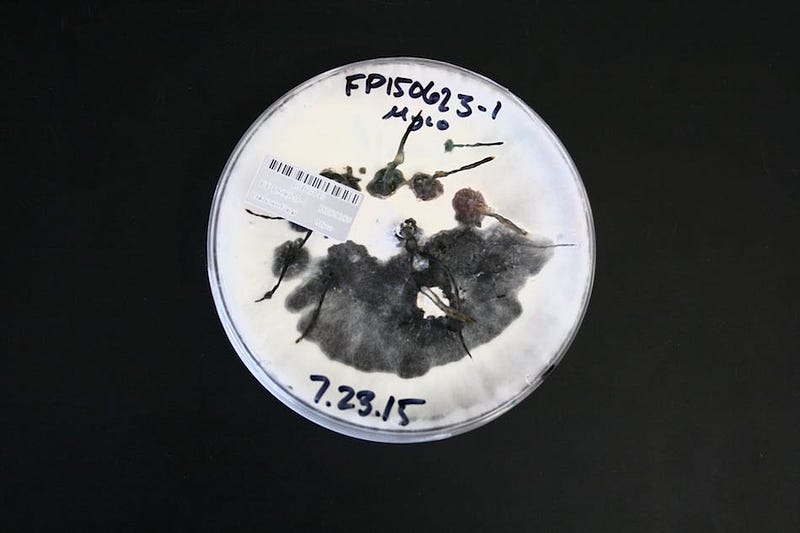By Stacy Montgomery

As antibacterial-resistant disease prevalence and seriousness increase, are scientists desperately searching for new antibiotics. Traditionally, researchers look into bacteria-rich soil for the antibiotics; however, continuing with this strategy has yielded little novelty. In the Currie Lab at UW-Madison, researchers like graduate student Heidi Horn have focused on a different, unique niche to find new antibiotic bacteria: ants.
“A lot of bacteria in the soil have useable antibacterial properties, but experiments on the ants haven’t shown them picking up any additional bacteria and putting it to use.”
These scientists came to the conclusion that the answers may lie with the ants by observing the existence of ants through an evolutionary perspective. It’s been long observed that ants have a mutualistic relationship with a fungus. An estimated 50 million years ago, some ants evolved an agricultural ability to grow fungus, and since then, the two species coevolved. The ant’s mutualism with the fungus is obligate, meaning one cannot survive without the other. To combat pathogens invading their delicate system, some species of ants have evolved with a bacterial symbiont to provide antibiotic protection from these pathogens. To focus her research to yield results, Horn specifically focuses on the relationship between ants and bacteria by asking how the relationship evolved in the first place and how it is maintained.
In order to study the ants, the Currie lab has sent scientists like Horn out into the world to find ants with specific qualities such as the agricultural fungus farming adaption and bacterial coating. Several ants partake in such agricultural behavior, but the leaf cutter ants that the Currie lab has curated are mainly from Panama and South America, with only a few species found in North America. Their nests are typically subterraneous, but some are in dead logs, and some even grow their fungus on the underside of leaves. To find these ants, the scientist simply scours the grounds looking for the specific ant and then, once the ant is spotted, follows the ant all the way home to find its nest (which can sometimes take hours).
The birth of these colonies begins with a new Queen, who takes a bit of the fungus from her parents (an inoculum, in scientific terminology), and starts her own colony, where the worker ants continue to culture the fungus by feeding it bits of plants, dead vegetative material or even bits of insects. Then the Queen and the larvae take up residence within this large mass of fungus, and survive by eating it. Interestingly, the ants found inside the mass of fungus are covered in a fuzzy white coating, which are the visible bacteria, while the adult worker ants only have this coating under their heads since they are not always in contact with the fungus.
“What’s really good about this system and why it’s a good model is that you can actually isolate the components and grow bacteria cultures on plates because this isn’t a mutual obligate relationship,” Horn says. The results from being able to disassemble the system have shown that the bacteria differs from ant population to ant population. Therefore, if the bacteria are different, it’s possible that the resulting antibiotics are different. As genome sequencing is becoming more affordable, researchers may begin to focus more on genes called secondary metabolite clusters, which are responsible for antibiotic production. Horn explains, “An interesting result from sequencing the genome shows that the bacteria are capable of creating a lot more secondary metabolites than we can see. So one of the big questions is: what causes them to produce this difference in metabolites?”
Horn explains that in theory, different metabolite cluster expressions are probably a result of different environmental stimulations. One might wonder whether the ants would pick up additional antibiotic bacteria from the environment. Horn clarifies, “It might make sense that they could exchange bacteria with the environment. A lot of bacteria in the soil have useable antibacterial properties, but experiments on the ants haven’t shown them picking up any additional bacteria and putting it to use.” A key point to consider is that the only predator to the ants’ fungal food source is called escovopsis, which is a fungus only found in this system. Because of this, the bacteria found on the ant is very specifically adapted to killing the pathogens in escovopsis (further supporting the idea that the bacteria, ant, and fungi coevolved).
Regardless, new antibiotic properties are right there in the ants. The process of developing a new antibiotic, from discovery to human use, is time consuming and take anywhere from 15 to 20 years. “The first test of these antibiotics is a fungal pathogen test, in which the activity is measured,” Horn explains. “With good results you can move on to identifying what the bacteria really is and what dosage you would use for fungal pathogens. Then it goes on to mouse models, which is still a long ways away from human trials.”
This interesting relationship between ants, fungi and bacteria is just one of the many complex systems found on this planet from which humans can extract something useful to our health. The research being done at the Currie Lab’s is a great example of the importance of continuing to research fundamental science. The answers are out there, and now we just have to find found (probably with a microscope).
